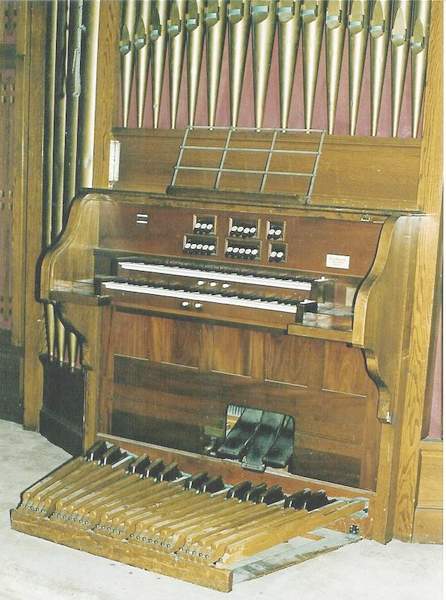Great
8' Gr. Open
Diapason 61
8' Gr.
Clarabella
61
8' Gr. Dolce
61
4' Gr. Principal
61
Great Unison
Off
Great to Great
4'
Swell
(Enclosed)
8' Sw.
Gedackt
61
8' Sw. Salicional
61
4' Sw. Flute
d'Amour 61
8' Sw.
Oboe [labial]
(tc) 49
Tremolo
Swell to Swell 16' &
4'
Swell Unison
Off
Pedal
16' Ped.
Bourdon 30
Couplers
Swell to
Pedal
[8]
Great to Pedal
[8]
Swell to
Great
16,[8],4
Finger
Pistons
Swell &
Pedal
1 - 3
Great &
Pedal
1 & 2
Foot Levers
REV [Great to Pedal] Reversible
Pedal
Movements
Swell
Expression balanced
Great Expression balanced
Crescendo
balanced
Action: Tubular-Pneumatic key & stop
Voices: 9
Stops: 9
Ranks: 9
Pipes: 506
Notes
The organ is housed in
a free-standing, quarter-sawn oak case. The facade is divided into
three sections arranged: 4 - 15 - 4.
Of these 23 gold pipes
with red trim, 17 are from the Great 8' Open Diapason. The
original cost of the organ was $2,350.00.
In addition to the
regularly engraved stoptablets, each tablet has raised brass braille
markings.
The organ was
originally built for the Washington State School for the Blind, and it
was installed in an auditorium in a building called "Old Main." An
agreement preceding the contract was signed between Sadie E. Hall (Superintendent for the school) and Mr. H.C.
Ferris
(Estey representative and
organ erector) on May 13,
1919. In the agreement, provision is made for the Great organ to
also be under expression like the Swell, and the console was to be
detached from the case and located on the auditorium floor immediately
in front of the stage apron. For the satisfactory completion of this
work Mr. Ferris was to receive $150.00 in cash.
Two
original contracts seem to have been provided. One has typed-in blanks and is
signed by J.E. Estey.
The other has blanks filled-in by hand, and is signed by
Mrs. Sadie E. Hall.
Over the years, the
organ fell into disuse, and by the early 1960's, the organ was largely
unusable. It was declared surplus by the State of Washington in
1972, and was then moved to an auditorium/theatre at Fort Worden State
Park in Port Townsend, WA. by the State Parks and Recreation
Commission. The organ was later moved to the Fort Chapel where it was
not reconnected and remained as an attractive but silent backdrop to
weddings.
In the early 1990's,
the School negotiated to re-acquire and bring the Estey back home. It
was removed from Fort Worden with volunteer labor headed by Mr. Richard
Woolridge of Battleground, WA. on December 16 & 17, 1994. Alumni
funds are being sought to restore and upgrade the organ for
reinstallation in its original home - Old Main Hall - which is listed
on the National Register of Historic Places.
Over the years, much of
the lead action tubing was damaged beyond repair, and several small
pipes have been
surreptitiosly removed.
Plans are to electrify the action and to connect the organ to a
computer system that would allow
the stoplist to
be altered at will.
Sources
Estey opus list
James Stettner
Extant agreement and two contracts
Extant organ as examined at Fort Worden two weeks prior to removal
Telephone conversation
with Dean O. Stenehjam, Superintendent of the WA. State School for the
Blind


